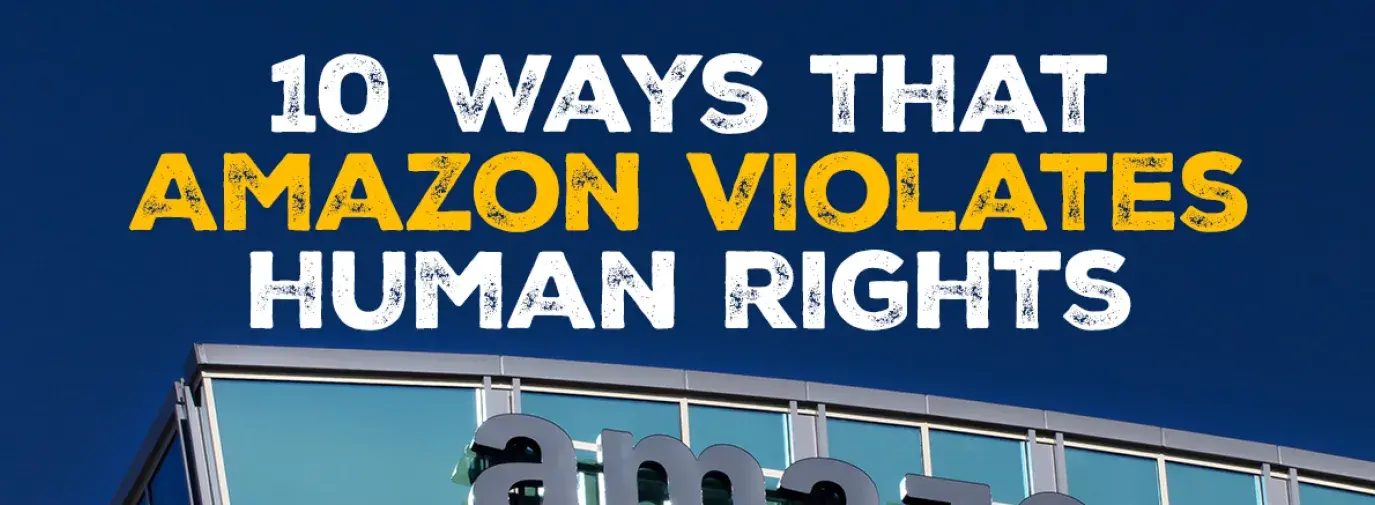As the world’s largest company, Amazon has a huge affect on the global economy. It also employs between 500,000 and 1 million individuals, and the way it treats those employees matters. Here are some of the worst human rights abuses that Amazon has either directly or indirectly contributed to.
10 Ways Amazon Violates Human Rights
- Amazon risks the health of workers in US. During the pandemic, nearly 20,000 Amazon employees have contracted COVID-19. Additionally throughout the pandemic, warehouse workers have voiced concerns of Amazon not taking enough precautions, which was supported by lawmakers when they made a surprise visit to an Amazon facility. Additionally, injury records analyzed by Reveal at the Center for Investigative Reporting demonstrate that injury rates within Amazon warehouses are more than DOUBLE the industry average; this is attributed in part to high production quotas.
- Amazon risks the health of workers in their supply chain. While Amazon does have a Restricted Substances List (RSL) of restricted or banned chemicals to protect consumers of some products from toxic exposures, it does not apply to electronics or apparel. Amazon does not share which harmful chemicals are and are not allowed in their electronics or apparel supply chain; this means workers and consumers could be exposed to harmful chemicals with potentially lasting negative health consequences. Amazon does not have an MRSL (a list of chemicals that are restricted or banned from the manufacturing process) for any product and is therefore failing to protect workers.
- Amazon is STILL selling dangerous electronics and electronics accessories to consumers. CNN reports: “Since 2016, at least 1,500 reviews, covering more than 70 items, have described products exploding, catching on fire, smoking, melting, causing electrical malfunctions or otherwise posing risks, according to an analysis of Amazon Basics electronics and appliances listed on its website.”
- Amazon tries to silence workers. The National Labor Relations Board is accusing Amazon of illegally firing a warehouse worker who spoke out for safer working conditions. During the pandemic, Amazon has fired several other employees who were organizing for safer working condition. All workers have the right to a safe and healthy workplace – silencing and firing workers only makes the problem worse.
- In some Amazon Ring call centers, workers have ‘no choice’ but to sleep at work. NBC News reported that in the Philippines, after speaking up about their terrible working conditions, such as having no choice but to sleep at work, the conditions got even worse afterwards. During the pandemic, requests to work from home have been denied, resulting in workers coming to the call center with flu-like symptoms. "People are scared because we don't know who has it and who doesn't have it," an Amazon Ring contractor said. "But people don't have a choice, because it's either you will be infected or you will die of starvation."
- Amazon sells clothing from a factory blacklisted for its poor safety conditions. The Wall Street Journal found that sellers on Amazon have been listing clothing from a factory so dangerous that most other major retailers will not buy from it. This factory has no fire alarms and doors that lock from the outside to keep workers trapped inside.
- Facilitates the human rights crisis on the US-Mexico border. The Guardian reported that Amazon Web Services hosts the Department of Homeland Security's databases which allows "the department and its agencies to track and apprehend immigrants.” Amazon also works with Palantir, which has over $150 million in contracts with US Immigration and Custom Enforcement (ICE).
- Fights unions, resisting workers' right to freedom of association. Amazon is known for pushing back against unionization. Amazon reportedly has Whole Foods managers watch anti-union training videos and has fired numerous workers who were organizing their coworkers during the time of firing. And Amazon doesn’t stop there – Vice reported that, along with surveilling worker and union organizing, “Amazon uses social media to track environmental activism and social movements in Europe—including Greenpeace and Fridays For Future, environmental activist Greta Thunberg's global climate strike movement—and perceives such groups as a threat to its operations.”
- Amazon’s Ring allows police to access your video footage. Forbes reports that you can opt out of allowing police access to your data, but “they can request the footage directly from Amazon if it has been uploaded to the cloud and the request is sent within 60 days of recording - even if you deny police access to that footage.” Though a similar video doorbell service, Nest, has stated that it would not share footage directly with police, experts do have privacy concerns about both services.
- Amazon is listening to your private conversations. Amazon hires thousands of people to listen to your conversations. CBS reported individuals that are hired to review recordings from Alexa and noted that sometimes they review private conversations.
Learn more about Amazon's worker's rights issues at home and abroad. If you're ready to make the switch, here are sustainable alternatives to Amazon. Amazon’s profits are only possible due to the work of individuals around the world, from apparel supply chains to delivery drivers – Join us in calling on Amazon to step it up on workers’ rights!




